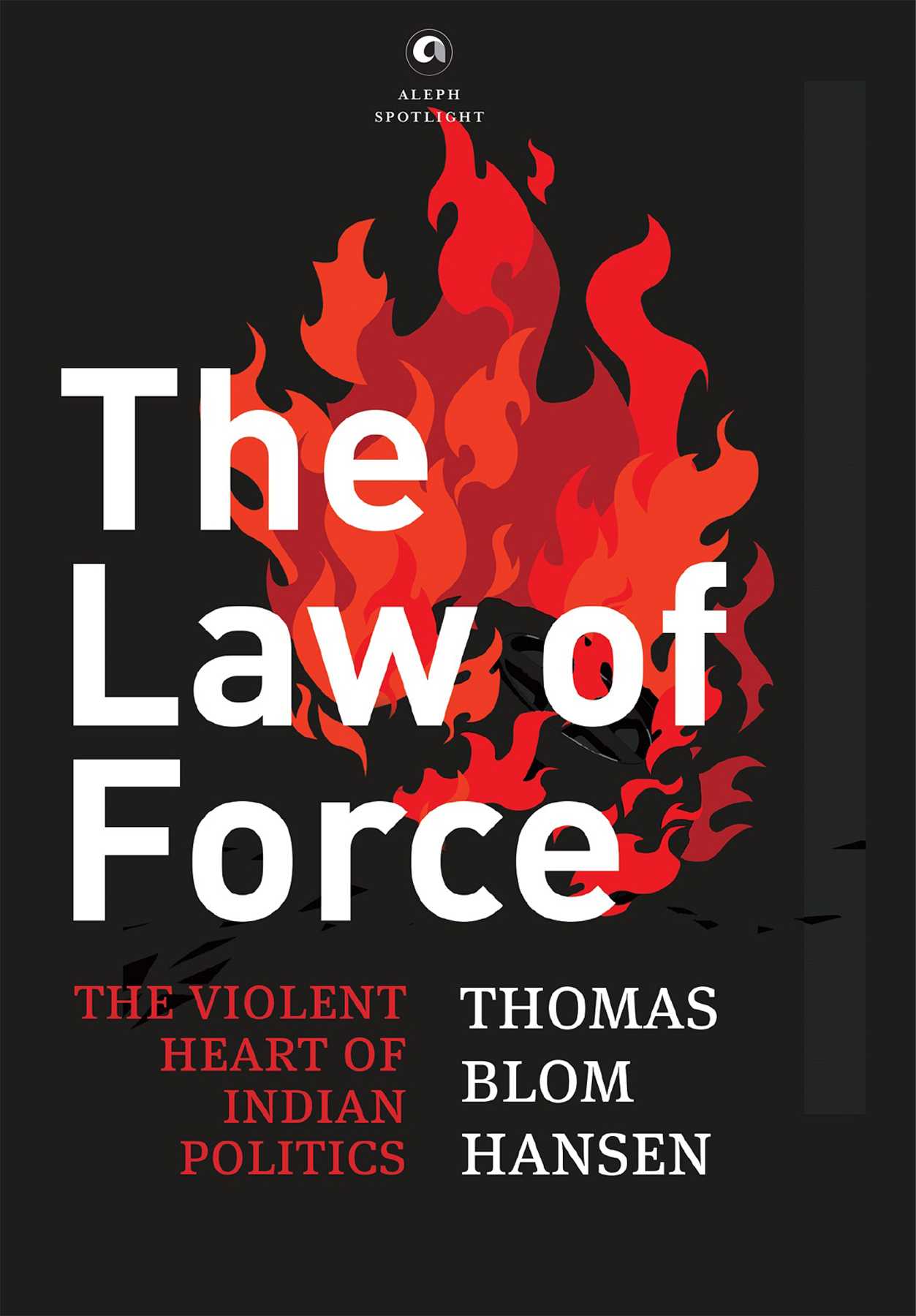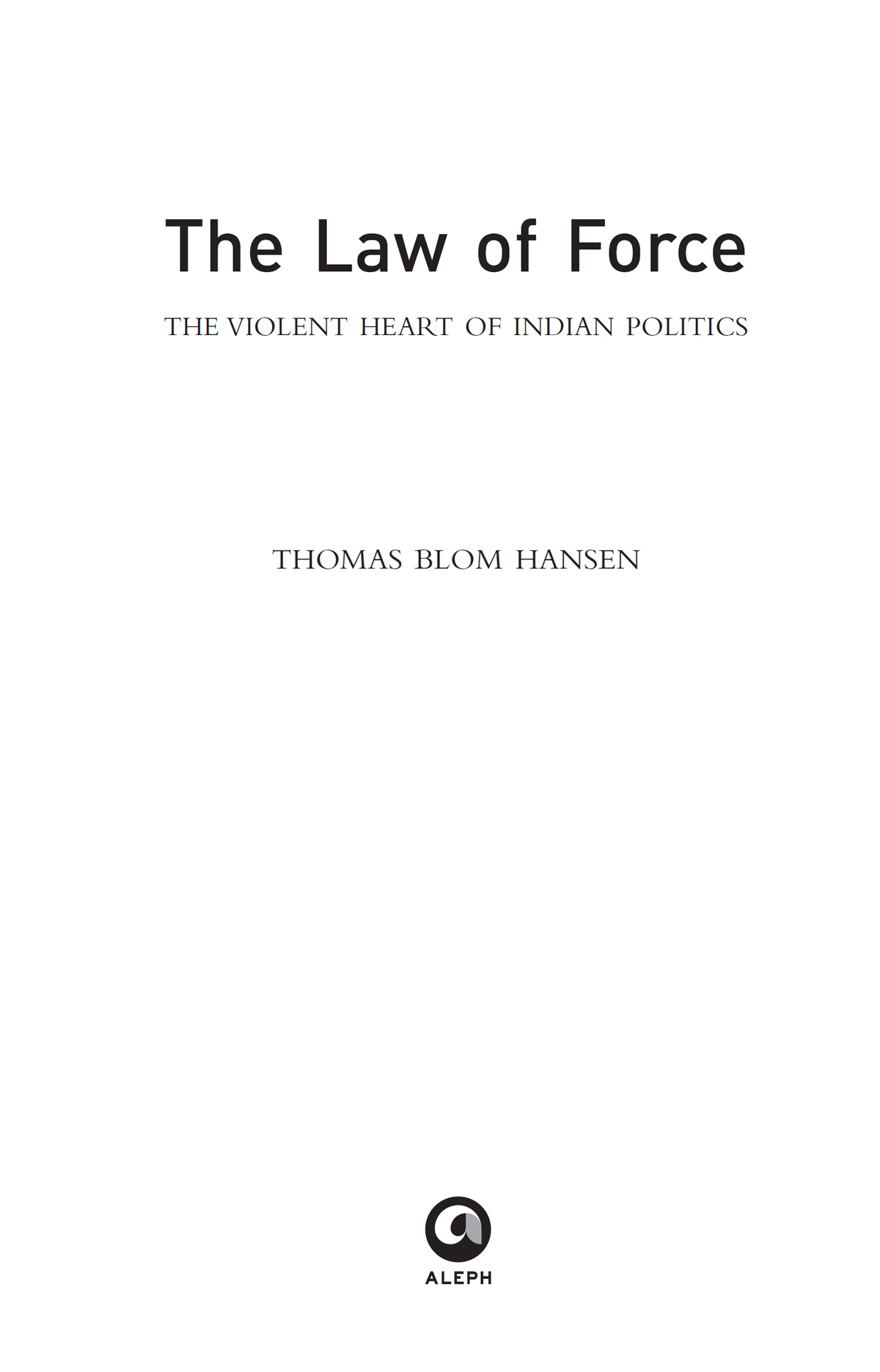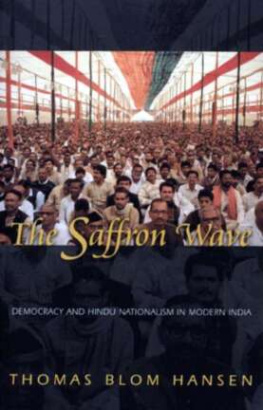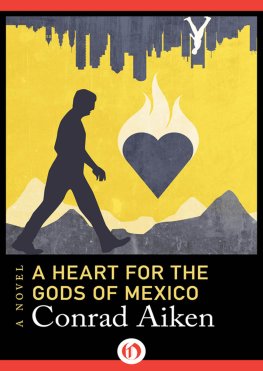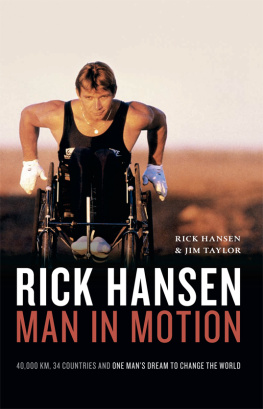Also by Thomas Blom Hansen
Majoritarian State: How Hindu Nationalism is Changing India (ed.)
Melancholia of Freedom: Social Life in an Indian Township in South Africa
Cool Passion: The Political Theology of Conviction
Sovereign Bodies: Citizens, Migrants, and States in the Postcolonial World (ed.)
Urban Violence in India: Identity Politics, Mumbai, and the Postcolonial City
States of Imagination: Ethnographic Explorations of the Postcolonial State (ed.)
Wages of Violence: Naming and Identity in Postcolonial Bombay
The BJP and the Compulsions of Politics in India (ed.)
The Saffron Wave: Democracy and Hindu Nationalism in Modern India
ALEPH BOOK COMPANY
An independent publishing firm
promoted by Rupa Publications India
First published in India in 2021
by Aleph Book Company
7/16 Ansari Road, Daryaganj
New Delhi 110 002
Copyright Thomas Blom Hansen 2021
All rights reserved.
The author has asserted his moral rights.
The views and opinions expressed in this book are those of the author and the facts are as reported by him, which have been verified to the extent possible, and the publisher is not in any way liable for the same.
The publisher has used its best endeavours to ensure that URLs for external websites referred to in this book are correct and active at the time of going to press. However, the publisher has no responsibility for the websites and can make no guarantee that a site will remain live or that the content is or will remain appropriate.
No part of this publication may be reproduced, transmitted, or stored in a retrieval system, in any form or by any means, without permission in writing from Aleph Book Company.
ISBN:
This book is sold subject to the condition that it shall not, by way of trade or otherwise, be lent, resold, hired out, or otherwise circulated without the publishers prior consent in any form of binding or cover other than that in which it is published.
Introduction
VIOLENCE IN THREE SCENES
PUNE, 16 JULY 1989
I sat under a tree in a small park in the Old city in Pune. I was in the early stages of what was to become an almost decade long period of research on the Hindu nationalist movement. Next to me sat a grey-haired man dressed in the signature Rashtriya Swayamsevak Sangh (RSS) uniformwhite shirt and khaki shorts. He was a long-standing pracharaka full-time RSS workerwho had devoted his life to the movement. He was a mild-mannered man who spoke in a low but intense voice, frequently smiling, eyes twinkling with excitement. I was struck by the violent eloquence of his words that seemed quite unusual at the time. Here is an excerpt from my notes from that day:
We in the RSS are often called extremist but that is wrong. We are simply trying to teach Hindus to stand up and defend their own house. Our Mother India has been raped by invaders for a thousand years. The invaders are still here and their mentality is still arrogant. But Hindus are the majority in this country, it is our country, not theirs, and we need to show them strength. That is all they understand..If every Hindu man and boy respects our Hindu culture and is physically courageous, our enemies have no chance.
He gestured at the boys and young men in RSS uniforms playing kabaddi in the park behind us. We will beat them back, shed blood if necessary, but we will show them their place. Today they are guests in our house, and must behave like that. We Hindus are tolerant and forgiving, but if they dont respect the rules of hospitality, they must be taught a lesson.
In the years to follow, I would hear endless variations on these themes as this type of violent speech and action entered the mainstream of Indian public life.
CENTRAL BOMBAY, 25 JANUARY 1993
The gigantic city was still eerily quiet. The curfew had been lifted in most parts of the city and the jawans from the Rapid Action Force (RAF), a specialized wing of the Central Reserve Police Force of India (CRPF), had withdrawn after the violencemostly attacks by Shiv Sena supporters and the police on Muslim areas and houseshad stopped ten days earlier. I was sitting in the house of my friend Asif, a gentle and refined writer, journalist, and occasional cartoonist. Everyone in the family was relieved to be able to move around again after almost two weeks of curfew. Asif asked me to come for a walk, as we usually did in the early hours of the evening. I want to show you what happened here, he said. We walked down towards the main junction. The street was quiet, people were watching us, apprehension and fear still written on their faces. Asif pointed to the walls behind us. Look what they did, he said. There were large letters sprayed on the wall Babur ki auladon, bhago Pakistan aur Kabristan in Hindi, and in English Muslims, Pakistan or Kabristan. Asif could not suppress his always bubbling wit, The Shiv Sena did us great honour here. They even brought one of their two-three intellectuals here to write this in Englishmust be the case, no, the spelling is perfect! We laughed and he said, Tell me the one about the three policemen. He loved this Russian joke: Why do Russian cops always move in threes? One could read, the other could write, and the third was to keep an eye on those damn intellectuals! We both laughed heartily, too loudly for the general sombre atmosphere around us. People looked at us, as we walked on. As always, Asif insisted that this was actually a story about Indian cops.
As we walked back, he showed me burned down houses and told me how many died in each of them, his voice laconic, his face sad and motionless. We turned a corner near his building and he pointed to a makeshift dwelling on the pavement, now abandoned. There was this little boy calling for his father, from down here, for days. At some point, I could not bear it any more so at night I went down to give the boy milk and biscuits. He was all alone and very frightened. Asifs voice broke, now he is gone.
An elderly man came up to us and wanted to shake my hand. He looked disturbed, as if in shock, saying, Shukriya, shukriya, again and again. Asif pulled me along, distressed, There are so many people like him, just walking around. What they must have done to that old man.
AURANGABAD, 8 JANUARY 2018
It was early evening in Nagsen Nagar, a predominantly Dalit slum area near the railway station in Aurangabad. Some of my young Dalit friends had taken me to meet one of the hundreds of victims of extreme police violence that was unleashed against Dalit protesters. A week earlier, hundreds of thousands had come out in protests across Maharashtra, following the attacks on Dalit celebrations of the Mahar regiment that was central to the defeat of the Peshwa empire at the village of Bhima Koregaon outside Pune in 1818. A young man was lying on a mattress on the floor, his face, arms, legs, and body severely bruised and swollen. He told his story slowly and calmly: he had not been in the protests himself but two of his brothers had been there, one of them now in jail, the other had gone to relatives in a village. He had been beaten during one of the nightly combing operations where the police would roam through Dalit neighbourhoods in search of troublemakers and extremists who the police claimed to have identified in video and cell phone footage during the protests. The young man had been at home with his mother and sister when the police broke down the door to the house and rushed in to find him. They immediately started beating him with lathi, dragging him out of the house. One of his friends showed me footage on his cell phone of what had happened. The friend had been hiding on the terraced roof of his house right opposite and he had been filming, intermittently, anxious not to get spotted. In the footage, one sees the young mans mother and other women trying to stop the beating. The policemen, many of them concealed behind face masks, shouted invective, calling the women randi (whores), ganda log (dirty people), and deshdrohi (traitors). One can hear glass shattering as the policemen drag out a flat-screen TV, attack a new scooter, smash a laptop, and at the end bring out a brand-new bathroom sink which they smash to pieces. They even broke our new toilet bowl, and confiscated our cell phones. As the cops were busy destroying the TV, the young man gets up and flees into the darkness down one of the many alleyways.

